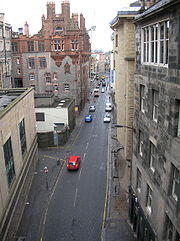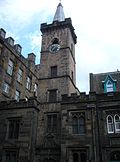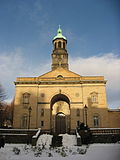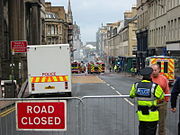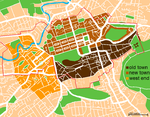- Cowgate
-
For other uses, see Cowgate (disambiguation).
The Cowgate is a street in Edinburgh, Scotland, located about 5 minutes' walk from Edinburgh Castle, within the city's World Heritage Site. The street's name is derived from the fact that cows were herded down it for Edinburgh's market days in previous centuries (gate being a Scots term for "street"; compare with gait).
The street is part of the lower level of Edinburgh's Old Town, which lies below the elevated streets of South Bridge and George IV Bridge. Consequently the Cowgate can be quite gloomy and dark in sections. It adjoins the Grassmarket at its west end and Holyrood Road to the east.
Although the area is now partly restored, and several new buildings have been constructed, from the mid 18th century until after the World Wars the Cowgate was a notoriously overcrowded slum area, where the majority of the city's Irish immigrant community was based. Among others, the Irish Socialist leader and revolutionary James Connolly was born in 1868 at number 107, and was executed following his role as a leader of the Easter Rebellion, an attempt to bring about Irish Independence.
In the late 19th century the area was known locally as 'Little Ireland'.[citation needed] Hibernian, the famous Edinburgh professional football club, were founded by congregants of St Patrick's RC Church on the Cowgate in August 1875. The club were based from St Patrick's until the early 1890s, and cups the club won from this period can still be seen displayed in the church.
Contents
Buildings
The oldest building lies to the west end, but is sandwiched between other larger buildings and easily missed. It stands on the south side of the street, just west of where George IV Bridge crosses over the Cowgate. This is the Magdalen Chapel, a 16th-century almshouse chapel built with monies left by Michael MacQueen in 1537. Work was completed in 1544 and it operated as a hospital almshouse (dedicated to Mary Magdalen) under the control of MacQueen's widow, Janet Rynd until her death in 1553, when it passed to the Incorporation of Hammermen (metalworkers). The entrance as seen from the Cowgate was rebuilt in 1613. The spire was added in 1620[1].
St. Cecilia's Hall was built for the Musical Society of Edinburgh in 1761; it houses a small Georgian concert space and a small musical museum owned by Edinburgh University[2].
St. Patrick's Roman Catholic Church stands at the east end of the Cowgate. It dates from 1772 but was extensively remodelled in 1929 following demolition of the tenements along the north edge of the Cowgate which previously obscured its frontage[3].
2002 fire
At eight o'clock on the evening of December 7, 2002, a fire started above a nightclub in the street. It quickly took hold, spreading to buildings on the South Bridge. The fire was difficult to control as it spread through the uncharted vaults beneath the South Bridge. The fire claimed no lives, but nonetheless destroyed many buildings, including much of the University of Edinburgh's School of Informatics, the Edinburgh Fringe venue the Gilded Balloon (which has since relocated to Teviot Row House) and La Belle Angele nightclub.
19 fire crews in total attended the blaze when it was at its height, the majority from Lothian and Borders Fire Brigade. It took over a day to bring the fire completely under control. Two main transport arteries, the Cowgate and South Bridge, remained closed for several days following the fire.
The University researchers and students affected worked in the field of Artificial Intelligence (AI). The University of Edinburgh was a pioneer in the study of AI in the 1950s and one of the world's most comprehensive archival libraries in this field was destroyed by the fire. Little current research data was lost in the fire due to offsite backups. Since the fire, the School has been dispersed over a number of sites. In 2005 work began on a new building, the Informatics Forum, which was occupied mid-2008.
The First Minister of Scotland appealed to the UNESCO World Heritage Fund for money to assist in the redevelopment of the site.
As of November 2009, the site is still a gap site, but is now entirely owned by developer Whiteburn, who have a proposal for a new mixed use development using the site and existing adjacent buildings. The site has been temporarily used as a Fringe venue again, becoming the C Venues' Urban Garden during the 2007 and 2008 Festival.
Buildings affected
- University of Edinburgh
- School of Informatics, South Bridge
- Adam House
- The Edinburgh Fringe's Gilded Balloon venue and offices for both the Gilded Balloon and Underbelly venues
- La Belle Angele live music and nightclub venue
References
- ^ The Buildings of Scotland: Edinburgh by Colin McWilliam
- ^ http://www.music.ed.ac.uk/euchmi/sch/
- ^ The Buildings of Scotland: Edinburgh by Colin McWilliam
External links
Mass casualty club fires Pre 1940 Study Club fire1940–1969 1970–1979 Club Cinq-Sept fire · Blue Bird Café fire · Whiskey Au Go Go fire · UpStairs Lounge arson attack · Summerland disaster · Beverly Hills Supper Club fire1980–1999 Stardust fire · Alcalá 20 nightclub fire · Happy Land fire · Kheyvis · Ozone Disco Club fire · Gothenburg discothèque fire2000–2004 2005–2009 Categories:- Streets in Edinburgh
- Old Town, Edinburgh
- History of Edinburgh
- 2002 in Scotland
- Burned building and structures
- University of Edinburgh
Wikimedia Foundation. 2010.

